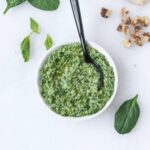Love eggplant and want to share with baby? Here is everything you need to know about serving eggplant (or aubergine) to babies using a baby led weaning approach, including how to cut eggplant for BLW, how to cook it, and baby-friendly eggplant recipes!

Eggplant, also called aubergine, is not a common first food for babies, but if a great option for baby led weaning babies to try if your family enjoys the veggie. The flavor can be somewhat bitter, which is good to introduce to babies at a young age to broaden their palates. While it is typically included in mixed dishes, many of which are perfectly fine for BLW babies to eat, eggplant can also be enjoyed as a side dish. Here is how to cut, prepare, and serve eggplant with a baby led weaning approach.
Jump to:
Can Babies Have Eggplant (Aubergine)?
Yes! As soon as babies are developmentally ready for solids around 6 months of age, they can eat eggplant. Eggplant is too tough (and generally tastes unpleasant) when raw, so it will require cooking until soft. Once cooked properly, eggplant flesh transforms into a soft and creamy texture, which is great for babies!
Eggplant Health Benefits for Babies
Eggplant is high in fiber, which is good for baby's digestion and gut microbiome. It also contains several vitamins and minerals, including manganese, folate, potassium, B vitamins, choline, and vitamin C. Eggplant is high in phenolic compounds, which act as antioxidants - especially anthocyanins, which help protect the body against free radical damage.
How To Serve Eggplant for Baby Led Weaning
Eggplant should be cooked to a very soft texture before serving to babies. The flesh will become soft and creamy. You can serve with the skin for easier gripping (baby will scrape the flesh from the skin and leave the skin when he's done), or remove it, especially if it becomes frustrating to baby.

1. Wedges (6+ months)
Cut eggplant into wedges or spears before cooking. Wedges should be about as long as your finger for easy handling for babies who are still learning how to pick up food. Leave the skin on if the flesh is especially soft so that baby can more easily grip a piece. If the eggplant is cooked to where it can still hold a little shape (but still passes the smash test!), you can remove the skin.

2. Bite-Sized Pieces (9+ months)
Once baby has started to develop a pincer grasp (usually around 9-10 months of age), you can offer eggplant in smaller, bite-sized pieces. Cut eggplant into pieces about the size of your fingernail either before or after cooking. You can serve with or without the skin. If the eggplant still has a little shape, you can also offer it on a baby fork for utensil practice.

3. As a Dip or Spread (6+ months)
Eggplant is often used in dips and spreads, such as Baba Ganoush, Kashke Bademjan, Zaalouk, or Melitzanosalata. These are great for serving to babies on a preloaded soft spoon or spread thinly on a piece of lightly toasted bread.
Tip: When picking one out, look for smaller eggplants as they tend to be less bitter. It should have firm skin with no bruises and can be stored at room temperature for a few days.
Best Ways To Cook Eggplant For Babies
Eggplant can be prepared several ways, though most often you will probably find it in a mixed dish. If you're cooking eggplant alone, some good options are:
- Roasting: Toss eggplant wedges or cubes with plenty of olive oil and any seasonings you like. Spread on a baking sheet and roast at 400°F for 20-30 minutes, stirring occasionally. Larger wedges or tougher eggplant may take longer.
- Sautéing: Heat olive oil in a large pan over medium heat. Cook eggplant cubes, spears, or slices in a single layer for 5-7 minutes per side or until soft. Flavor with any spices or seasonings you like.
- Grilling: Generously oil slices or wedges of eggplant and grill over medium heat for about 4-5 minutes per side, or until soft.
Baby Led Weaning Friendly Recipes with Eggplant
Many recipes call for salting eggplant before cooking. This was traditionally done to remove bitterness, but today's eggplants are much less bitter and the step is really unnecessary. Skip the salting step to reduce the sodium content for baby (and save you some work!).
Read more: Can Babies Have Salt?
- Creamy Eggplant & Caramelized Onion Dip (Kashke Bademjan) by Minimalist Baker
- Melitzanosalata (Smoky Greek Eggplant Dip) by The Mediterranean Dish
- Stewed Eggplant in Tomato Sauce by Real Greek Recipes (omit the sugar)
- Eggplant and Italian Sausage Baked Ziti
- Mediterranean Roasted Eggplant by Steam and Spoon
- Ratatouille by The Cozy Apron (skip the salting steps)
- Eggplant Parmesan Orzo by Serving Dumplings

FAQ
When cooked properly, eggplant is not a choking hazard. The tough skin, though not a choking hazard, can be cumbersome to babies just learning to eat and can be removed if needed. Always make sure to follow the safety guidelines anytime baby is eating!
No, eggplant is not a common allergen. It is in the nightshade family, so some people who react to certain nightshades may also react to eggplant.
Yes. If you offer a large spear or wedge of eggplant, baby will just scrape the flesh off and leave the skin. If you offer eggplant in small pieces, baby can eat the skin. If it starts to frustrate baby or causes gagging, remove the skin.

















Leave a Reply